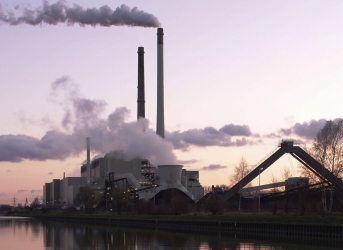It's a big question for America's big electricity producers.
Will rising natural gas prices push producers back to using coal?
After all, natural gas prices are breaking out above their recent low trough in the $2.60/mcf-$3.10/mcf (million cubic feet) range.
It's true that North America's natural gas prices are decided by its electricity producers. The gas producers have held supply constant—roughly 64 bcf/d (billion cubic feet per day) this year – despite $2/mcf gas.
Power companies have increased demand by about 6 bcf/d in 2012—even in the spring, before the torrid summer heatwave began.
That represents just under 10% of total US demand. That's why the power producers are the big swing vote. Without them, gas would still be under $2/mcf.
So if they switch back to coal, the natural gas rally could get halted dead in its tracks.
“I would predict that if the price of natural gas climbs sustainably above US$3.25, some 10 per cent of that switched would switch back to coal. And that percent would climb if prices rose to US$4,” said energy veteran Thomas Drolet, who is formerly head of Ontario Hydro International.
When natural gas prices started falling from averages of around US$4.50 per mmBtu in January 2012, power generators started switching to the cheaper fuel from coal.
RELATED: Oil Markets Limp into Fourth Quarter
I follow the natural gas markets closely, but I’m not an engineer. So I wanted to know—logistically, how easy is it for these big electricity companies to switch back from natural gas to coal?
Well, it’s as easy as changing a nozzle.
In most power plants, fuel is pushed to boilers via nozzles. The nozzles either spray powdered coal or natural gas to ignite and heat up tubes with water circulating in them. The steam generated by the hot water drives the turbines, which in turn generate electricity.
It’s quite simple to change nozzles to accommodate different diameters and pressures. Many plants can handle both gas and coal and can move from one to another in a matter of hours—as in one, eight-hour shift. Older plants can take days, however.
As well, access to natural gas for a change-over to coal would be an issue if the power plant is not located close to a pipeline system, Drolet noted.
So, as natural gas prices are now rising-up to $3.50/mmBtu (1 mmBtu ~ 1.1 mcf), coal prices have dropped to around US$52 per ton from US$78 per ton, the equivalent of US$2.03 per mmBtu.
RELATED: What Impact does Oil have on the Syrian Civil War?
The $1.40+ per mmBtu discount to natural gas this week is the largest relative price difference since August 2011, according to Reuters data—providing, on paper at least, lots of incentive for electricity producers to start switching back and reducing natural gas demand—potentially a lot.
However, the tipping price point for fuel switching depends on the utility and the age of the generator.
A Reversal for Natural Gas Prices?
The U.S. Energy Information Administration (EIA) predicts natural gas consumption, which is estimated to rise by 5% this year from 2011 on power generation demand, will reverse in 2013 as prices rise and utilities switch back to coal.
“Because of the projected increase in natural gas prices relative to coal, EIA expects the recent trend of substituting coal-fired electricity generation with natural gas generation to slow and likely reverse over the next year,” the agency said in its September short-term energy
“EIA expects that coal-fired electricity generation will increase by nine percent in 2013, while natural gas generation will fall by about 10 percent.”
The other side of the coin is voiced by Ziff Energy analysts in Calgary, Alberta, who argue rising volumes of natural gas – produced as associated gas with shale oil and natural gas liquids, as well as shale gas – will conspire to put a ceiling on prices, despite low drilling activity on both sides of the border.
“We see a lot of production in the system and many wells waiting for pipelines to be built and to connect to,” said Ziff's Senior Manager of Gas Services, Cameron Gingrich. “We’re seeing a big surge in Marcellus and other shale, so taking everything into account, I don’t see gas supply dropping any time soon - or prices rising.”
Drolet also suggests U.S. power generators could also move to natural gas because of looming emissions limitations by the Environmental Protection Agency.
Utilities such as Minnesota’s Xcel Energy said they would shut down smaller coal-fired power plants, saying natural gas-fired facilities were cheaper to build than installing costly pollution control equipment on existing coal units.
Ohio-based American Electric Power Company recently said it has burned a quarter less coal in the past four years, about 55 million tons in 2012 from 75 million tons in 2008, while doubling natural gas use.
“However, should natural gas, as some people believe, increase to an average of US$3.25, then price really becomes the primary reason, especially the more coal prices fall,” Drolet concludes. And the market is there now.
By. Keith Schaefer, Publisher, the Oil & Gas Investments Bulletin



















The old, clunker-type steam plants that use gas in their boilers can indeed accomodate different fuels, but not coal (easier to, say, switch over to diesel). Coal boilers are very tempermental--coal from different mines requires a complete retuning, sometimes. And all the fuel handling infrastructure is vastly different -- coal piles, and conveyors, and that's only after you actually have the stuff on site. You need a rail link or a barge depot to get the stuff in (a typical coal plant can burn 4 trainloads (that's 400 train cars) of coal a DAY.
the coal to gas switching will take the form not of moving a nozzle, but instead of flipping a swtich. The large coal plant that was operating at 10?pacity will get ramped to 90%, and vice-versa for the gas plant.